The way 3D printing has gained momentum in recent years was unprecedented. From a fantasy of science-fiction movies, it has become an easily attainable reality for most of us.
In consequence, the range of 3D printing filaments has also diversified over the years. Two of the most popular choices in this category have been Acrylonitrile Butadiene Styrene and Polyethylene Terephthalate Glycol.
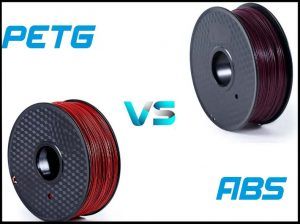
Although they provide similar benefits, there are some stark differences between them.
Let’s explore them all in our head-to-head comparison of PETG vs ABS today!
What is PETG?
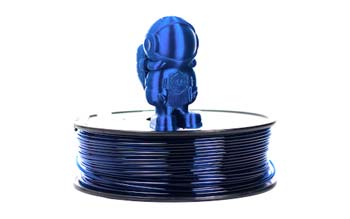
PETG or Polyethylene Terephthalate Glycol is one of the most popular filaments for 3D printing. This transparent thermoplastic filament is basically an upgraded version of PET. It has garnered rave reviews and heavy attention among the 3D printing enthusiasts due to its incredible flexibility.
This filament is manufactured by using a chemical called CHDM (cyclohexane dimethanol) to copolymerize PET. Since it is the product of copolymerization, PETG is also known as copolyester or CPE.
The glycol content of this material saves it from getting crystallized. It attains a lower melting point which makes PETG an ideal choice for 3D printing. Usually, this value is close to 230°C. Its sticky nature makes for better layer adhesion and thus greater strength.
Advantages of PETG
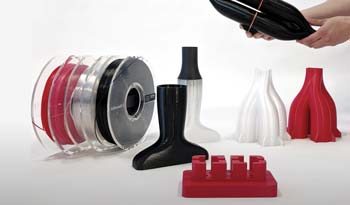
Highly Durable
PETG is mainly known for its incredible durability. It has exhibited exceptional resistance in both chemical and physical aspects. You don’t have to worry about your printed structure breaking down because of pressure with PETG. It doesn’t react negatively to acidic or alkaline substances.
Although PET responds negatively to overheating by becoming brittle and hazy, PETG is not susceptible to such deformations. This filament can withstand heat better because of its glycol content. With a tensile strength of around 7,700 psi, it can easily compete with polycarbonate in terms of resistance and durability.
Easy to Use
You will get plenty of freedom to use this PETG in a number of ways. That is because it doesn’t come with many restrictions or demands. Firstly, it is not so prone to shrinking or warping like many other 3D filaments. So there will be less chance of damage or post-processing tasks while working with PETG.
The transparent 3D filament allows easy coloring. As a result, you can paint your finished product in any shade you want. Unlike PET, you can sterilize it and put it through the RF sealing process. You don’t have to worry about unpleasant odors while working with PETG since it doesn’t produce any during printing.
Food-Safe
If you are not impressed with the bottles and containers available in the market, you can make some of your own with PETG! It is one of the food-safe plastic filaments and holds a certificate issued by the FDA. So you can use it to make any kind of food container or bottle without worrying about a toxic ingestion.
Read More: Can You 3D Print Food Safe? We cover food-safe 3D prints and 3D-printed food in this guide!
Environment-Friendly
Similar to most thermoplastics, you can fully recycle PETG. Being made from polyester, it is biodegradable and also 100% recyclable. So the next time you decide to make business cards, containers or any other structure from plastic, you can choose PETG to avoid any guilt of damaging the environment.
Disadvantages of PETG
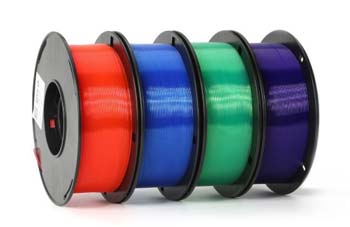
Prone to Stringing
Unfortunately, the PETG filament is prone to stringing because of its sticky nature. The end product can have threads sticking out from some parts of the surface walls. That is why you should never use PETG for printing structures that include intricate details or require sharp parts.
Temperature Issues
While its low melting point does bring tons of benefits for the users, it also has some drawbacks. Firstly, you can never store it in a place where the temperature is higher than usual. That can cause the filament to chemically react with its container material and ruin its properties.
Learn How to Store 3D Printer Filament properly in this informative guide.
Prone to Scratching
Even though PETG makes a great filament because of its flexibility and impressive impact resistance, these same features make it more prone to scratching than other materials like acrylic and glass. As a result, you have to handle the printed product carefully and place it somewhere safe from children and sharp objects.
What is ABS?
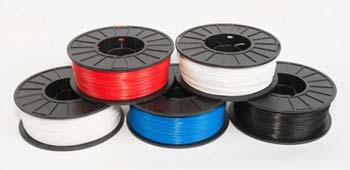
ABS is short for Acrylonitrile Butadiene Styrene. Like PETG, it is another highly popular choice for 3D printer filaments. It is prepared with a base of petroleum and then a number of hydrocarbon monomers. This yellow-colored filament is very easy to process and goes through the machine smoothly. If you know a little about another 3d printer PVA filament, as we’ve done on our PVA filament post.
Even before the inception of 3D printing technology, it was already a favorite plastic. It was first developed in the 1940s and gained momentum in the next decade. Since then, ABS has been extensively used to build a wide variety of objects including bike helmets, keyboards, medical devices, toys and LEGO bricks.
Advantages of ABS
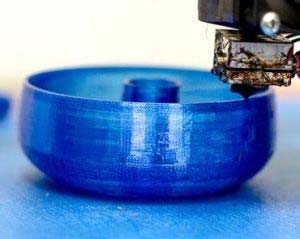
Durable
Products made out of ABS plastic can last a long time if you store it away from direct sunlight. You don’t have to worry about children or surrounding sharp objects ruining its appeal. ABS can withstand scratches and keep the surface safe from getting ruined. So it is protected against wear and tear.
Sturdy
ABS is a very strong material that can survive high heat, stress and pressure. When you apply pressure to its surface, it tends to bend rather than breaking. Such a high endurance makes ABS a good choice for including in the manufacture of home appliances and automobile parts.
Easy to Process
ABS filaments don’t clog or jam the hot end while extruding in high temperatures. Besides, you can easily process the ABS product surfaces with acetone. It also allows gluing the parts or file off the sections which are not necessary anymore. To enhance its aesthetic appeal, you can color it with any shade of acrylic paints. This ABS plastic post has some additional tips to easily cut ABS plastic.
Affordable
You don’t have to break a bank or be a large enterprise to try out printing with ABS filaments. It is quite an economical option for amateurs and small business owners alike. You can get a kilogram of ABS spools under just twenty bucks. The price can go even lower if you settle for pellets.
Disadvantages of ABS
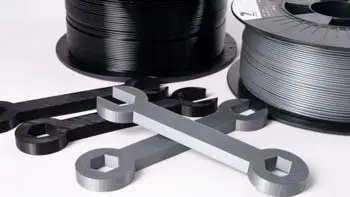
Temperature Issues
If you are trying to print out a structure with a large standing surface, ABS may not be the ideal filament for that. ABS is prone to warping, curling and shrinkage during 3D printing.
Besides, you need to keep an eye on the cooling process after printing is done. Cooling it too fast can result in cracks on the surface. We recommend using a 3D printer with an enclosure for it.
Printing Odor
Make sure you have kept the windows and ventilators open while working with ABS filaments. Printing 3D objects with this material can discharge a bad odor across the room. Even after the job has been terminated, the stench of used ABS filament can keep the surrounding unpleasant for a while.
Environmental Damage
Unfortunately, ABS is not an environment-friendly 3D filament. It is biodegradable and manufactured from a non-renewable source like oil.
Even though it can be recycled, doing so will result in a lot of waste materials and energy consumption. So if you care about the environment, not using ABS will be the better option.
Read More: ASA vs ABS Filament. See what makes these filaments different!
ABS Vs PETG: Head To Head Comparison
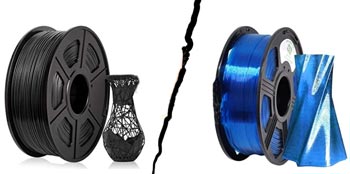
Applications
PETG is used in a wide variety of projects like signs, graphic holders, store fixtures, orthotic devices, prosthetics, tabletop displays, prototypes, thermoformed trays and machine guards.
Its ability to be sterilized even in harsh environments makes it a good choice for medical implants and packaging for medical devices and pharmaceuticals. Since PETG is food-safe, it is used to make plastic food containers, cooking oil containers and drinking bottles.
On the other hand, ABS has been used for a long time in bicycle helmets and LEGO bricks. In the case of 3D printing, it is used to make tough parts that can last a long time and can withstand heat. The products here usually include toys (like fidget spinner), enclosures or cases and automotive hardware.
Read our related article, How Long Does 1kg of 3D Printer Filament Last? We cover different types of filament and how to get the most out of your spool!
Susceptible to Warping
ABS is a lot more susceptible to warping than PETG. You have to manage the temperature carefully while working with ABS. It can stay as solid up to about 100-degree Celsius which means the extruded plastic can solidify fast. As a result, warping can take place soon after.
Also read: 9 known 3D printing issues.
Temperature Management
It is harder to deal with the temperature controls during an ABS printing than a PETG printing. ABS needs a heated bed while PETG can do without one. Moreover, ABS requires very high temperatures for the heated bed which cross way beyond 100°C. So the printer should have a heated build chamber.
Odor
PETG does not produce any odor during printing. Even if there is an odor, it’s almost negligible. The degree of particle emission and VOC is also very low. However, ABS can emit both odors and heavy particles during the process which may cause health hazards.
Post-Processing
Post-processing tasks tend to be easier with ABS since it is a lot less hassle to use paint and glue on this material. Compared to PETG, ABS is the better option for cosmetic additions or modifications. Apart from the color and glue, they both can be used for metalworking and similar tasks.
Storage
PETG has higher hygroscopicity than ABS. As a result, it can absorb moisture from the surrounding air more easily. So you need to be very careful about storing it and keep it away from areas with high humidity. Besides, it is affected by UV rays. So PETG seems to be a better choice for both easy storage and outdoor use.
Strength
Although both have been known for their individual capabilities in strength, PETG turns out to be stronger than ABS in the end. This is probably due to the fact that PETG has better layer adhesion as a result of its sticky nature. However, both the filaments do show impressive strength for 3D printing objects.
Read our related article, What is the Toughest 3D Printer Filament? where we compare filaments to find the strongest option available!
Environmental Impact
ABS is a filament whose primary component is petroleum oil. So it is neither biodegradable nor comes from a renewable source. On the other hand, PETG has a positive effect on the environment by being sustainable, biodegradable and fully recyclable. So PETG is the wiser option for those who care about nature.
Temperature Resistance
In the case of temperature resistance, ABS seems to have the upper hand. While PETG can survive temperatures as high as 80°C, ABS can withstand 20°C higher. This means you can pour boiling water on ABS and it will still not be damaged. Other than that, both the materials can be good for general electrical appliances.
Cost and Availability
ABS is available in both spools and pellets. The first type costs between $14 and $60 for one kilogram. On the other hand, pellets come at a much lower price point of just around ten bucks! However, 3D printing with pellets will require special extruders. Lower cost can also result in lower quality so you need to invest wisely.
PETG costs a little higher and comes in transparent or solid colors. Their price range can be decent or premium depending on the provided quality. The PETG sheets are generally 12×12 to 60×96 inches in size.
Bottom Line – Which One is For You?
Both ABS and PETG are popular as 3D printing filaments. However, keeping most of these factors under consideration, the better choice in PETG vs ABS comparison seems to be PETG.
Although it’s a bit pricier, it is safer for the environment and comes with fewer restrictions in processing. You don’t have to worry about shrinking, warping or unpleasant odors while working with PETG.
On the other hand, ABS may seem to be a good option in many cases because of the lower price point, sturdiness, durability and less post-processing work.
But the necessity of a heated bed and high temperature, and less environmental sustainability may put it in the backpedal for the beginners in 3D printing.
Other 3D Printer Related Article: